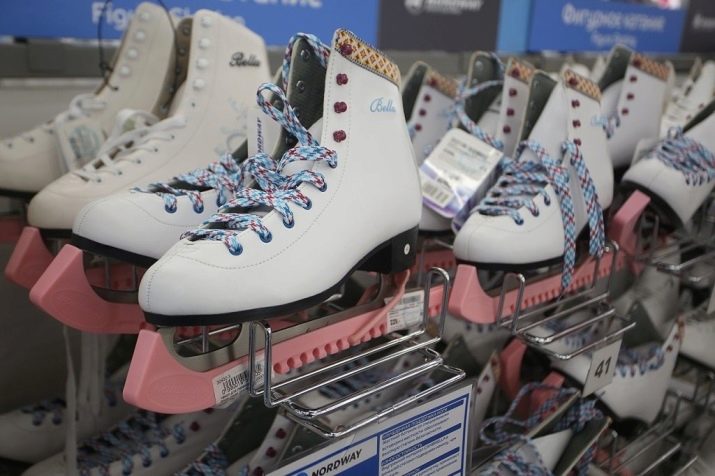Everything you need to know about figure skating
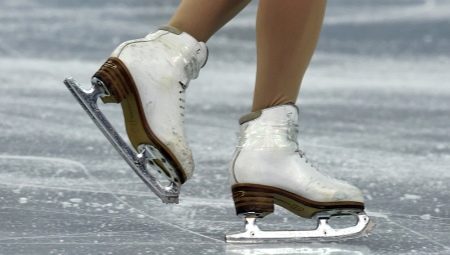
The success of both the athlete and the hobbyist on ice depends on the quality of the skates. Even if at first glance it seems that everything is in order with them, you need to know the nuances that distinguish real sports equipment from cheap imitation. In the article, we'll talk about the types of figure skates, tell you how they differ from the usual options, and how to choose them correctly.
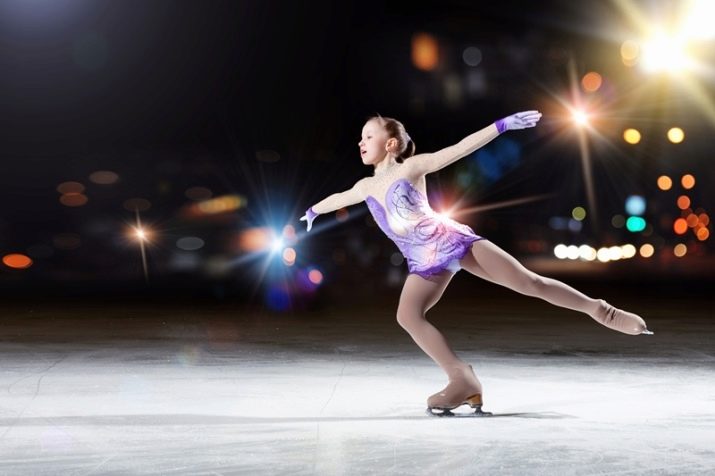
general description
To perform elements of increased complexity on the ice, you need unusual sports equipment. Products for skaters must be stable, agile and comfortable.... Figure skates meet all these requirements: they can stand on their toes, jump, spin, but there is one important point - they can only move in one direction. Let's figure out what are the features of the shoes and blades of figure skates.
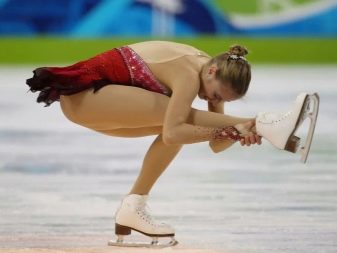
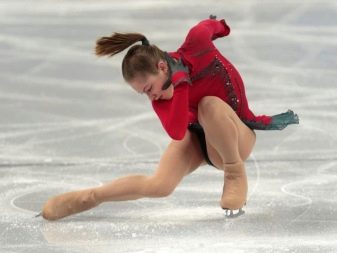
Boots
To have an idea of the curly products, you should take a closer look at their structural elements.

The outer part of the boot
Let's start with the outside of the shoe. Most often, the boot is made of leather. She "breathes", keeps warm, nicely wraps around the leg. The disadvantages include only low-quality impregnation, which makes the models heavier, you should pay attention to this during the purchase.
Professional boots are sewn from a triple layer of leather for increased rigidity. To reduce the cost of production, amateur footwear is produced from plastic or leatherette. The products are lightweight, fit well on the leg. But they do not allow air to pass through, the leg sweats in them, the models are not durable and wear out quickly.
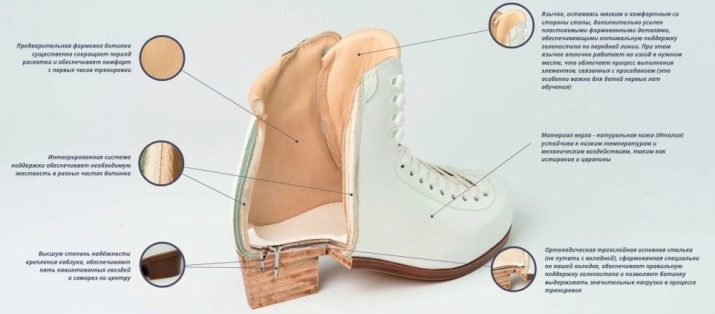
Lining
The lining plays an important role for the comfortable stay of the foot in the boot. In expensive shoes, this is a soft, comfortable, pleasantly shock-absorbing layer between the foot and the top of the product. In cheap versions, it also performs the function of a seal.
Sometimes athletes thermoform the liner. This is done privately using special ovens. After the procedure, the inner part of the boot perfectly follows the contour of its owner's foot.

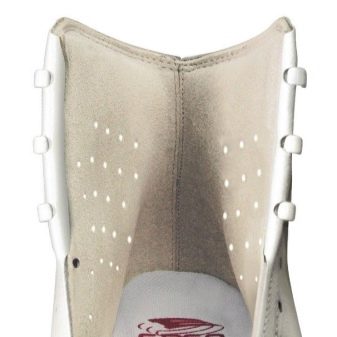
Sole
It is not of fundamental importance to the skater's shoes, since contact with the surface occurs through the blades of the skates. But for professional products, the sole is still made of leather. It absorbs well while jumping, neutralizes vibrations, and helps to keep warm air in the boot. For amateur options to reduce the cost of production, a plastic sole is often installed. Its advantages are light weight, and its disadvantages are lack of strength and durability.
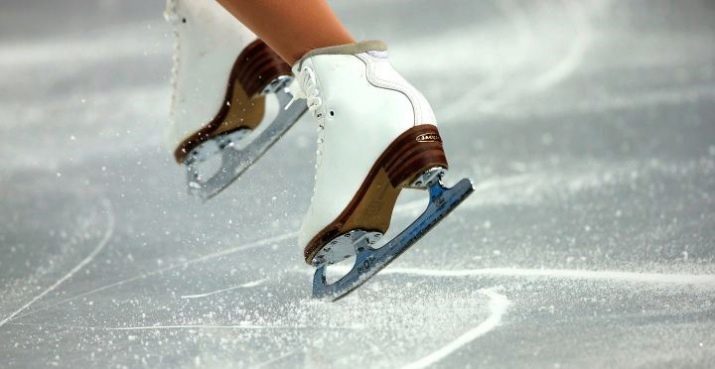
Heels
The heel is a feature of figure skates. Thanks to him body weight is distributed correctly... High heels are used for dancing in the ice arena, and low heels for free skating. Professional athletic shoes are provided with a leather molded product, while recreational boots are fitted with plastic versions.
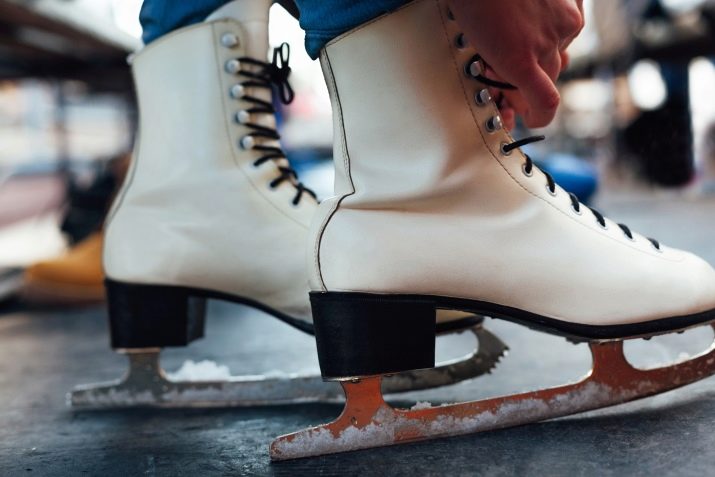
Rigidity
This is the most important characteristic for an athletic shoe of this kind. The stiffer the boot, the tighter the ankle is held, the less chance of tucking and injuring the ankle... High rigidity is necessary for jumping, for riding with heavy loads, for daily training. In this mode, any other shoe will not survive even a couple of weeks.
With a tough model, the professional athlete can count on seasonal skiing. For children, beginners and amateurs, on the other hand, soft models are needed that have a budget cost. It will be uncomfortable for them to ride in hard shoes.
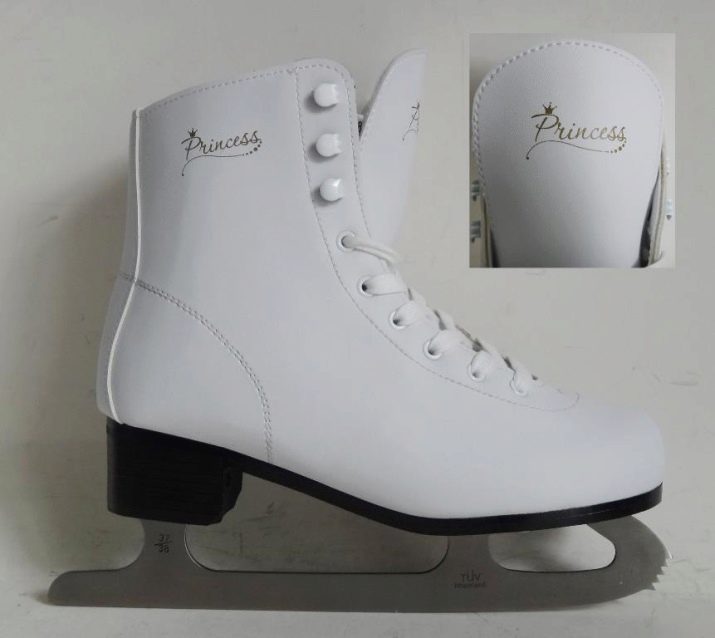
When buying, it is not difficult to check the degree of rigidity - you need to squeeze the boot over the heel with an effort with your hand. A soft model will be pliable, it will easily change shape, hard shoes cannot be squeezed even with effort.

Boot height
In Soviet times, it was believed that high boots were good. Modern technologies make it possible to produce footwear that makes it possible to fully hold the foot even in low-rise items.... Conversely, greater rigidity in a tall boot will obscure the freedom of movement of the ankle.
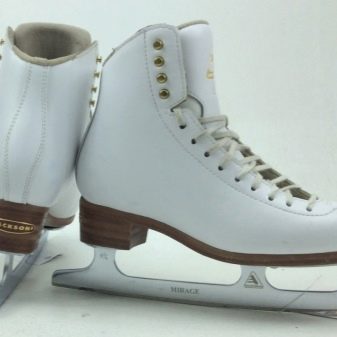

Blade
Now let's move on to a detailed analysis of the blade attached to the skater's boot. The success of an athlete, his achievements and awards depend on his contact with ice. Therefore, high requirements are imposed on such characteristics as quality of steel, size and contour of the ridge, number of notches, bending of the blade line and its height, groove depth, method of attachment to the boot.
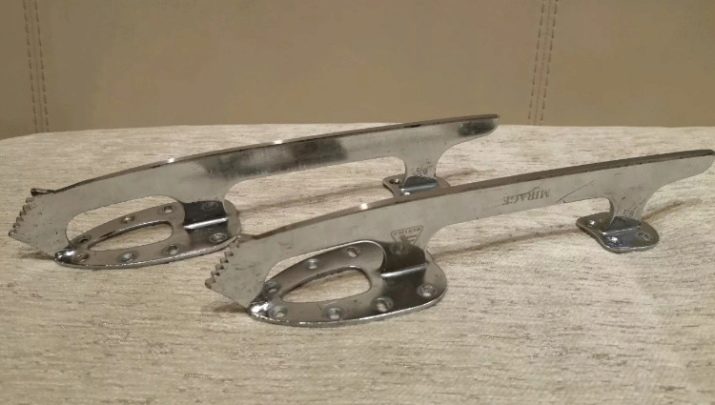
Barbs
What distinguishes figure skates from all other types is the presence of notches. They help the athlete to perform braking and various curly elements.
The teeth are located on the front of the blade and are above the level of the ice surface, so they rarely cling to it. Newbies can do without chipping, but their presence won't hurt.
It should be noted that on professional skates, the teeth are larger and more expressive than on amateur products.
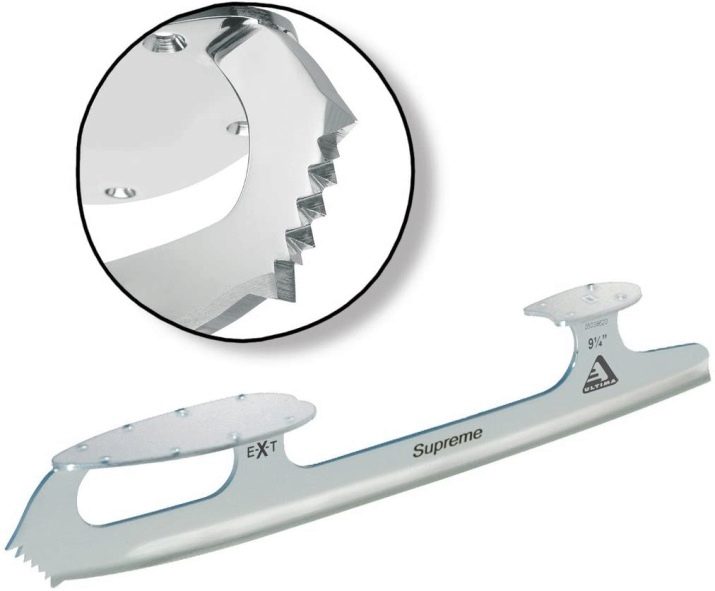
The size
Skaters have a long and wide blade. This gives stability when rolling, adds comfort, and helps to slide. Height has nothing to do with sliding, but it affects stability - the more squat the skate, the easier it is to stand on it.
The size of the blade is measured from the bottom toothed to the back of the blade and should fit the shoe. For skating without a pair, skates are chosen with a thickness of 4 mm, and for dancing - 2.5 mm.
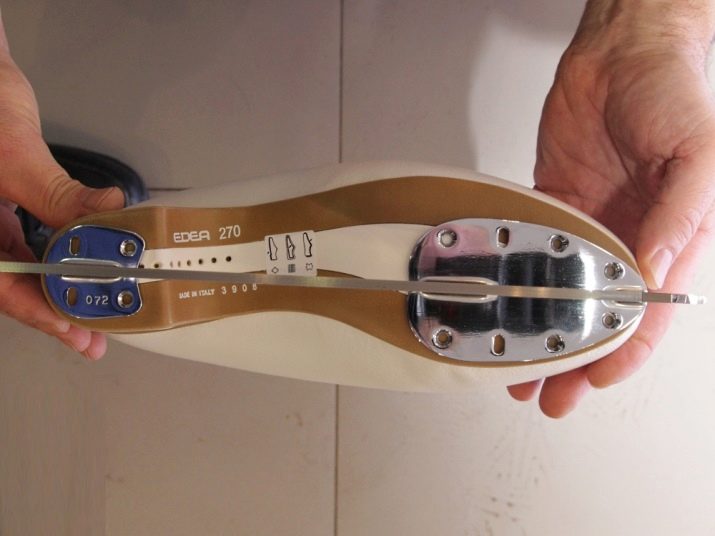
Grooves and ribs
The blade of figure skates is more complex than that of conventional models, it has ribs on the outside and inside, as well as a notch between them, which is called a "groove" or "groove"... It is on the edges that the skater glides on the ice.The adhesion of the skate to the ice surface depends on the sharpness of the ribs.
The depth of the groove affects the stability of the athlete, therefore it is important to monitor its timely sharpening, because over time, due to high loads, the volume of the groove decreases. It is important to remember that a deep groove improves the grip of the skate on the ice, but makes rotation and braking more difficult. Therefore, sharpening is done for the athlete individually, based on his preferences.
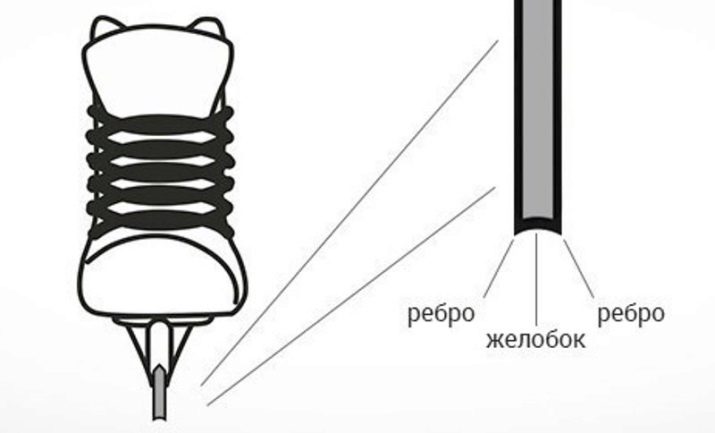
Radius of curvature
The radius of the blade affects stability and glide. The larger it is, the wider the area of contact between the skate and the ice, the easier it is to stand and move on them.... But at the same time, it is the small radius that provides maneuverability, high-speed rotation and convenience when cornering. Therefore, skates with a small radius are chosen by professionals, and with a large radius - by amateurs.
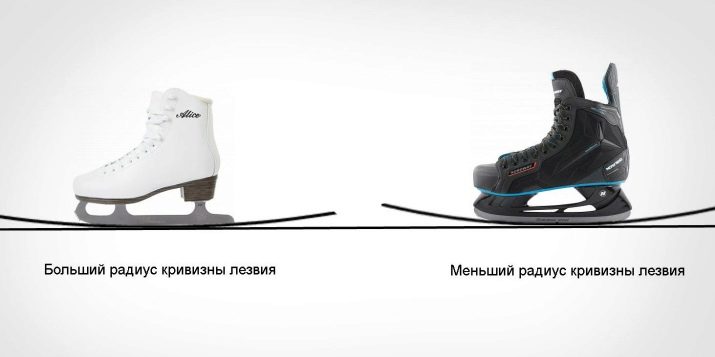
Metal characteristics
In the production of figure skates for sports purposes, a high-carbon chrome steel... Products made from it are lighter than cheap options, glide well, wear out less, do not corrode, and last longer.
Inexpensive blades produce made of alloy and low carbon steel. Skates are heavy and all the indicators listed above are worse.
About skates, you can also add the following - on expensive models, the blades are adjustable, adjusted to the athlete. The blades are removable and can be replaced when worn.
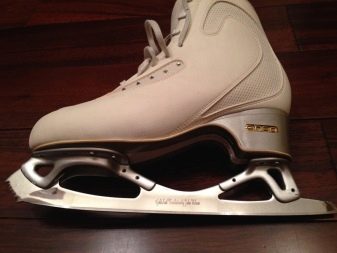
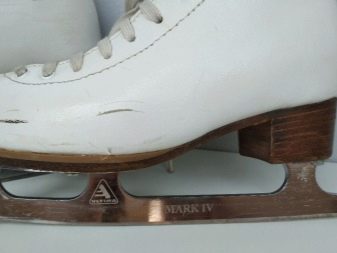
How are they different from ordinary skates?
Figure skates are designed not only for riding on ice, with their help all ultra-si elements (figures of the highest complexity) are performed, therefore, differences from conventional riding models can be found both in the blades and in the boots.
-
Figure skates taller and tougher walking options. The boots are three times stiff.
-
They endowed with an inner boot, which athletes often thermoform to fit the needs of their own legs.
-
Shoes, unlike conventional models, sits tightly on the legwithout giving freedom to your fingers.
-
Only for figure skates there are jags in the bow to perform complex elements and a protrusion at the back by 2.5-3 cm.
-
Figure skating shoes are supplied with heels.
-
You can move in figure skates in one direction only.
-
The blade device itself (groove between two ribs) refers to the outfit of skaters.
Real figure skates are made from quality leather and high carbon steel. All other options can be considered their "pale reflection".

Varieties
Figure skates are available for men, women, children, for amateur skating and for sports. Professional models are divided according to the type of riding. Taking into account age and professional characteristics, the equipment has certain differences.
By age and size
Skates for children, adults, for juniors, women, men are made of different parameters, the size grid can be from 24, 25 to 46 numbers.
Even knowing your own size, boots should still be tried on... They are tried on on socks that are usually used for skating. Some companies provide their own line of sizes, for example, the EDEA brand. It is enough to put your foot on the device with numbers and read the number corresponding to the shoe size. We suggest that you familiarize yourself with the transitional table of sizes for EDEA brand boots:
|
Shoe size |
26 |
27 |
28 |
29 |
30 |
31 |
32 |
33 |
34 |
35 |
36 |
|
Boot EDEA |
18 |
18,8 |
19 |
19,5 |
20 |
20,5 |
21 |
21,5 |
22 |
22,5 |
24 |
|
Length in cm |
17,5 |
18 |
19 |
20 |
20,5 |
21 |
21,5 |
22 |
22,5 |
23 |
24 |
|
Shoe size |
37 |
38 |
39 |
40 |
41 |
42 |
43 |
44 |
45 |
46 |
|
Boot EDEA |
24,5 |
25,5 |
26 |
27 |
27,5 |
28 |
28,5 |
29 |
29,5 |
30 |
|
Length in cm |
24,5 |
25,5 |
26 |
27 |
27,5 |
28 |
29 |
30 |
30 |
30,5 |
According to age, boots can be conditionally divided into three groups.
-
Baby refer to sizes 26-31. Small children can wear shoes that are adjustable to the length of the foot, as their training is not yet heavy.
-
Junior models range in size from 32 to 38.
-
Adult the figure skater corresponds to sizes from 38 to 46.
When choosing shoes, you should pay attention not only to the length, but also to the completeness of the product. Only perfectly fitted boots will give you pleasure and success in sports.
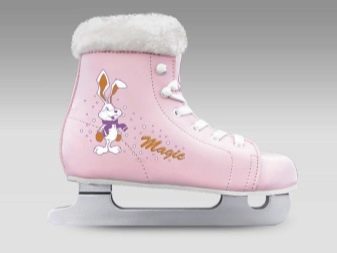
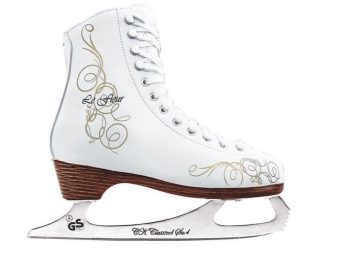
By appointment
Figure skating is an unusually beautiful multifaceted sport. It includes different types of skiing, which require special sports shoes.
Free skating
In this category, single and doubles performances are performed, accompanied by a large number of difficult elements and jumps. For athletes, the highest and stiffest shoes with low heels are required.... For beginners, you should choose models of moderate softness. A blade made of high-quality steel should actively protrude in the heel area and have pronounced teeth on the toe.
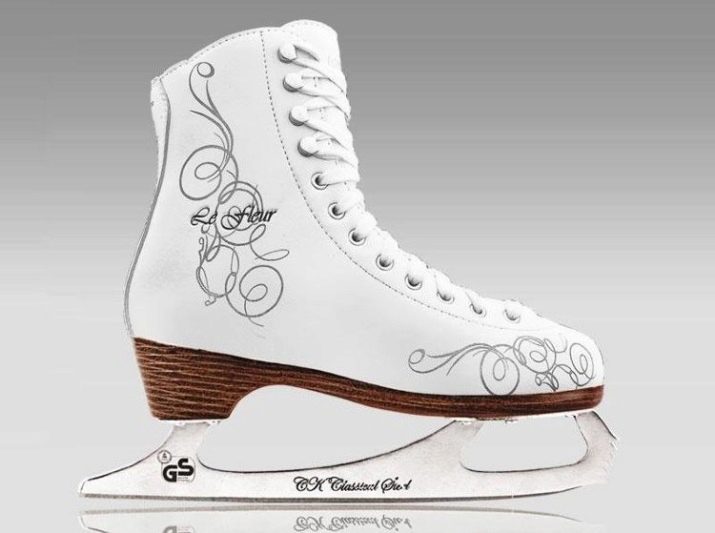
Walking (mass)
Such skates are not related to sports, are designed for the general public, and the requirements for them are not too high. The equipment can be used with friends at the public skating rink, and is also suitable for those who want to play sports, but are at the beginning of the journey. If you give the skates an increased load, they are demolished instantly.
Products for ordinary riding are distinguished by their budgetary cost and all the characteristics resulting from it - not genuine leather is used, but its substitutes, which do not have sufficient rigidity, the heels are made of plastic, the blade is made of low-carbon metal.
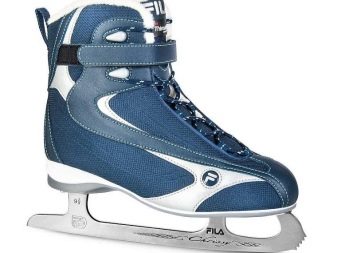
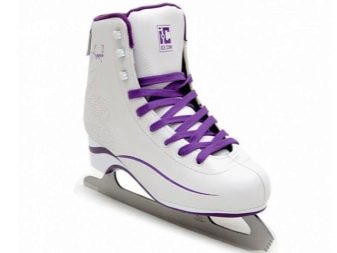
For dance programs
You need skates that can withstand the high speed test. Pair skating assumes a close distance between partners, skates in such situations should be minimally traumatic. To avoid accidental clutching of the blades, the rear projections are made small. The boots are thin, short, allowing the foot to move freely. The blade is endowed with a small radius and not pronounced serrations.

Synchronized skating
It does not differ in elements of increased complexity, the main feature is the synchronized movements of partners... For this type, low-stiffness skates are produced, with a shortened heel and a special type of lacing.
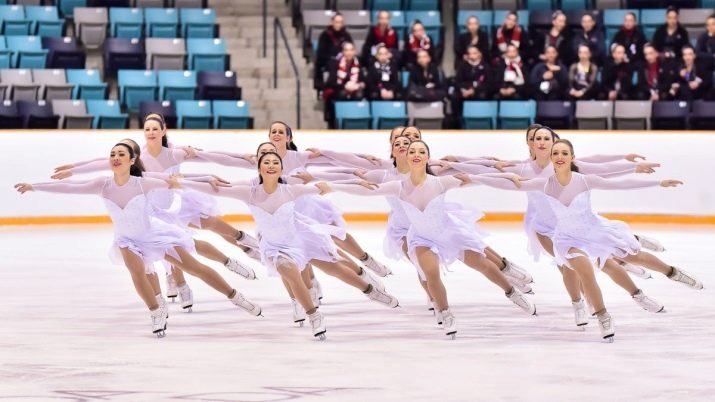
Coaching
The coach doesn’t have to do difficult elements, but he has to be on skates in a cold room all day long. Some firms produce special trainer boots of special comfort, soft and warm.
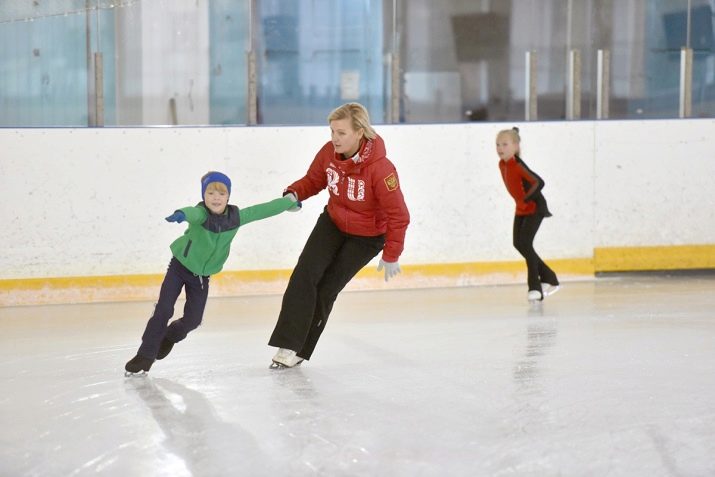
By riding skills
You can start skating at any age, if there are no medical contraindications. In accordance with the degree of progress towards success, the inventory is changed to a more suitable one. According to skating skills, figure skates are divided into three categories: amateur, semi-professional and professional.
Amateur
The budget version of figured adults and children’s skates is designed for outdoor walks, for skating on city rinks, for novice athletes. An amateur's outfit is produced soft, from inexpensive synthetic materials, the blades are made from alloy steel, the teeth are high, or they are absent altogether. Amateur skates are not used to perform complex elements, they are not loaded with hours of training. The quality of the material is quite enough for the periodic use of inventory.


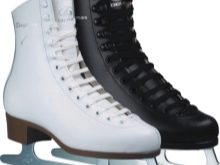
Semi-professional
Figure skates in this category are not yet considered professional, but they are already suitable for children, juniors and adults who have passed the beginner stages and master more complex movements, for example, rotations, double jumps. This outfit has a medium-hard leather upper and higher quality steel blades with serrated forefoot. The bend radius on the ridge is large, the groove is not very deep. The skates are capable of withstanding moderate training stress.
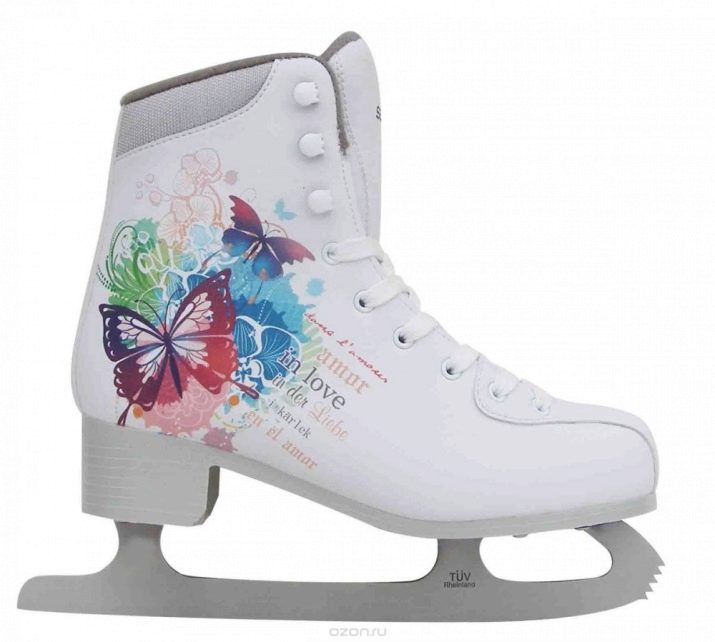
Professional
The sports boots are made from durable leather and the blades are made from the highest grade steel. The shoe has maximum rigidity, holds the ankle well. The blades are endowed with large notches, a deep groove between the ribs, glide perfectly on ice, in most cases have a small bend radius, are adjustable and removable.
Steel is difficult to sharpen, but keeps sharpening for a long time.
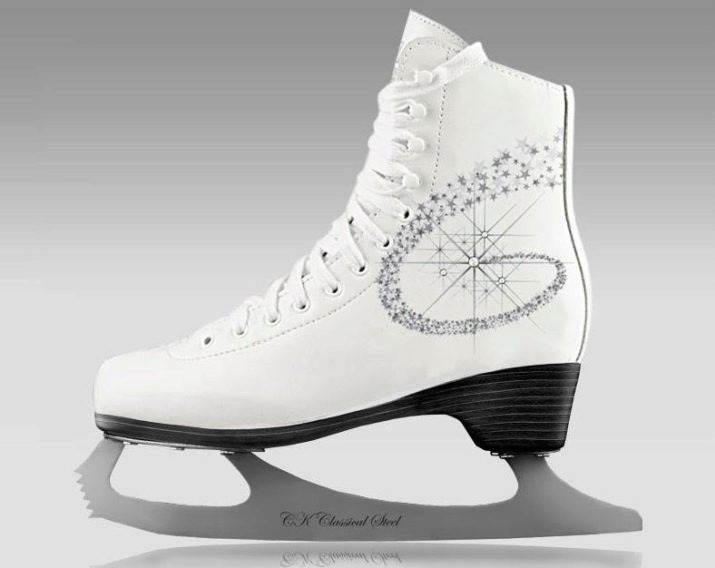
The best manufacturers and models
Figure skating is practiced by men, women, children with different preferences, so the classic black and white options are diluted with blue, red, pink, with a pattern, stitching, perforated inserts. Our rating will include not only the most expensive and beautiful top models, but also budget skates of good quality, representing well-known and reliable brands.
ATEMI AFSK-17.04 Axel
The skates have a loyal value, made of high quality artificial leather. Perforated inserts allow the foot to breathe and stay on the ice for a long time. The inner lining is made of warm, wear-resistant velveteen. You can skate at a temperature of -25 degrees, and your feet remain warm.

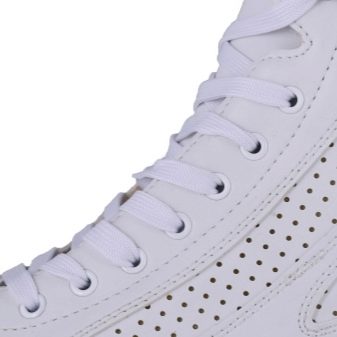
WIFA Prima Set
Universal skates (for boys and girls) of a professional category from an Austrian manufacturer. But they are designed for the first years of study, too complex figures in them are not easy to perform. The boots contain good leather and durable steel on the blades. They are stable, securely fix the leg, and have optimal rigidity.

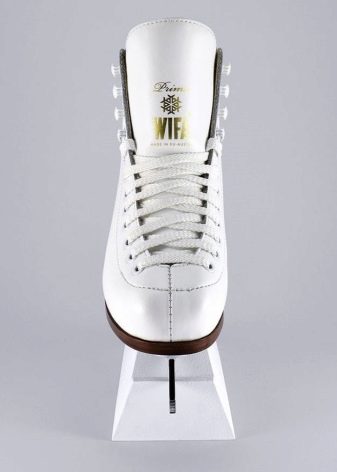
ICE BLADE Naomi
Budget skates with a nice design. The model is made of synthetic leather with faux fur inside. The legs feel particularly comfortable. The blade is durable and reliable, made of high carbon steel. The product is recommended for outdoor recreational riding.
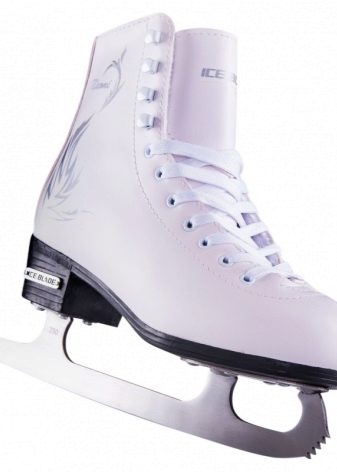

RGX Rental II
The boots are made of high-quality artificial leather that withstands low temperature conditions, does not crack in the cold and does not require lubrication. Internal fixation of the foot in the boot is flawless. The design of red shoes with dark inserts and brass clasps looks impressive.
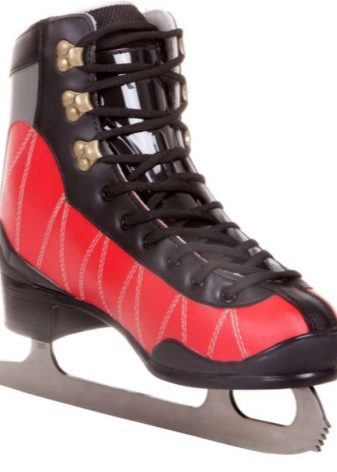
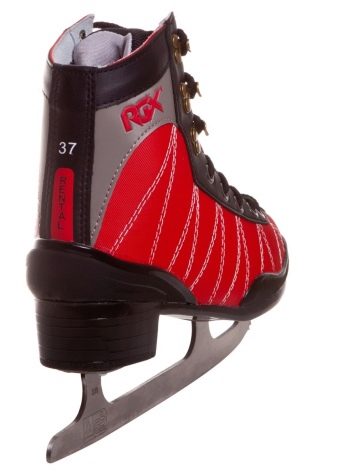
Components
Professional and amateur figure skates need renovation, some have torn laces, and some need to replace the blades. In specialized stores, you can purchase different types of accessories for boots and skates:
-
blades of various models in a large assortment;
-
sharpening stone Inf-Abrasive for SSM machines;
-
glass Bauer Tuuk, CCM E-PRO;
-
insoles by Botas, MAD GUY and other companies;
-
laces from Botas, MAD GUY, impregnated;
-
covers for different types of blades;
-
Velcro universal firms Racing;
-
bag for transportation of figure skates.

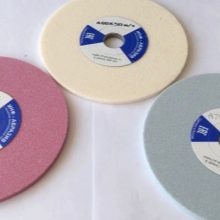

Criterias of choice
The choice of skates depends on the level of skating. Pros choose models with a triple layer of leather upper, reinforced with stiffness, with a high-carbon steel blade. Heel height and bend radius should be selected individually. The insert must be of excellent quality. Models need removable, adjustable.
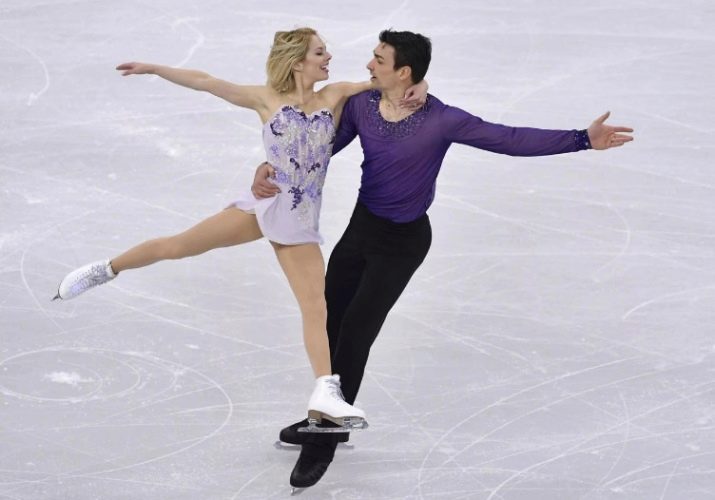
Those who are involved in professional sports know everything they need about their shoes. We will talk about choosing semi-professional and amateur skates.
-
If the material issue is not acute, it is better to prefer leather options, they "breathe", eventually take the form of the owner of the shoe. Leather models are wear-resistant and durable.
-
It's nice if the boots are soft, comfortable, ergonomic insidebut with a moderately hard outer layer.
-
The foot in the boot should not dangle, it could cause injury.
-
It is good if the upper cut of the shoe has anatomical shape, it adds comfort and safety to the feet.
-
Those who rarely skate and visit only indoor skating rinks may not overpay and buy boots with plastic soles and heels... They weigh a little, are inexpensive, but this is where their advantages end. Anyone who can pay for comfort is better off looking at leather options. Such a sole retains heat, the heel absorbs well, which means it relieves stress from muscles and joints.
-
If the manufacturer is too clever with lacing, it will be difficult to fit the boot to a specific foot; it is better to choose simple fixation options.
-
Shoes must have a perforated tongue and holes for proper air circulation... Only such boots can be used for a long time.
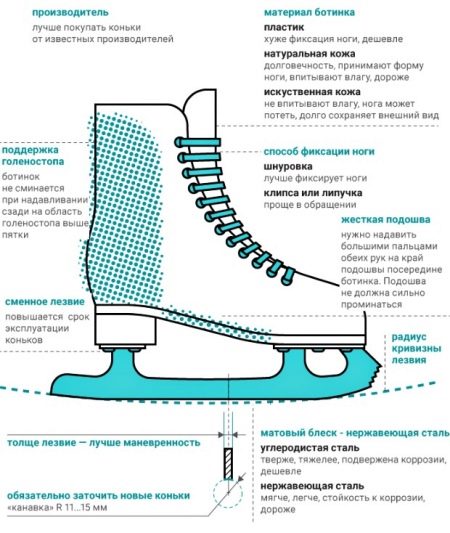
Choose your figure skates responsibly. Incorrectly selected shoes during operation will make you think about problematic moments and ruin the pleasure of riding.
